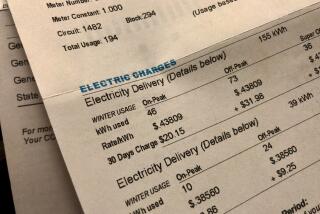‘Death Spiral’ Sends REA Co-Op in Colorado Into Bankruptcy Court : Power: Cheap loans fueled rural electrification unit’s spread throughout state. Then it cut its rates while costs rose. Now, it owes more than $1 billion.
- Share via
MONTROSE, Colo. — Like many rural Americans, Kathy Hall still remembers the day when the lights went on for the first time.
She was already in high school when power lines finally reached her family’s ranch on the wind-swept plains east of Casper, Wyo.
“It was incredible,” she said. “We had a refrigerator and a freezer and bright lights. We had pumps for the water instead of relying on the wind. We even had lights in the barn to milk by, and that was in the ‘60s, for crying out loud.”
And she remembers just as clearly who gave them that power: the federal Rural Electrification Administration.
“The REA was a magic word,” said Hall, now 46 and an aide to state Sen. Hank Brown in Grand Junction.
The REA, still an object of near-religious allegiance in rural America, today is under siege. Bush Administration strategists searching for ways to cut the federal budget deficit have attacked the billions of dollars in federal subsidies channeled by the REA to rural electric cooperatives nationwide.
In recent years, three of the nation’s 1,000 electric co-ops have been forced into bankruptcy, and an REA team is working with five troubled co-ops to head off new insolvencies.
One of the three co-ops in bankruptcy reorganization is Colorado-Ute Electric Assn. Inc. of Montrose, which owes the REA $415 million and private creditors $700 million. The company generates and supplies power to smaller electric co-ops covering more than half of Colorado, and, in many ways, its history parallels the growth of such cooperatives nationwide.
The REA was able to bring light to America’s most remote corners through low-interest loans and loan guarantees, subsidized by taxpayers. Using those loans, rural Americans formed their own nonprofit, cooperatives distribution systems, elected their neighbors to the co-ops’ boards and packed the annual meetings.
By the early 1940s, the co-ops got the idea of joining together to form their own generating and transmission companies. That way, they could build their own power plants and no longer have to buy electricity from privately owned power companies.
Somewhere along the line, things began to go wrong at Colorado-Ute.
Its former management and board of directors have been called incompetent by the state Public Utilities Commission, and last August a federal bankruptcy judge ordered the appointment of an outside trustee to run the company.
The trustee, Victor Palmieri of New York City, promptly dismissed two top officers and told the board its services were no longer needed.
Palmieri, who was also the trustee for the Penn Central reorganization, is reviewing several proposals for Colorado-Ute--ranging from a merger with another generating co-op in eastern Colorado to outright liquidation. He said he hopes to present a plan to the court by the end of the month.
Colorado-Ute probably will lose $38 million in 1990, Palmieri said, despite rate increases of 8% in 1989 and 12% in December.
How did Colorado-Ute go so terribly awry?
Colorado-Ute was incorporated in 1941 by its member co-ops as a generating and transmission company. It was formed with a total of $75 in capital, $5 from each co-op, according to Fred Kroeger, a former director of one of the co-ops, La Plata Electric Assn. of Durango, Colo.
The rest of the money came from the federal government.
Colorado-Ute produced its first power in 1959 at the old Nucla Station, growing to a system with numerous plants serving more than 600,000 people in all or parts of 49 of Colorado’s 63 counties.
The low-interest federal loans flowed. The utility grew and grew, building coal-fired power plants, investing in some hydroelectric projects and making grand plans for the oil shale boom that was supposed to transform western Colorado. But, in 1982, the boom busted, plunging the area west of the Rockies into an economic depression from which some parts still have not recovered.
In 1986, Colorado-Ute decided to lower its rates, as management persuaded the board that sales of power could be increased if the price were lower. The huge glut of electric power available in the western United States apparently wasn’t considered an important factor.
The utility began what economists call a “death spiral.” The costs of producing electricity rose as revenues fell, leading to heavier borrowing, higher costs and weaker revenues.
According to an audit by the Public Utilities Commission, the REA told Colorado-Ute’s president and chairman that it opposed the rate cut, but that objection was not passed on to the board or other managers. Nor did the REA follow up when the co-op lowered its rates.
Board members didn’t get--and didn’t ask for--monthly financial statements until after Colorado-Ute defaulted on its loans in March, 1989.
After the default, directors spent 40% more on themselves in directors’ fees and travel allowances than they had the year before. And they gave generous merit raises to members of top management.
Finally, last year, the REA, the utility’s single largest creditor, ordered a rate hike of 24%. The move has been contested in federal court by the state Public Utilities Commission, which claims the authority to set electric rates in Colorado.
Despite all of Colorado-Ute’s troubles, support for locally run cooperatives runs deep here, almost as deep as the mistrust of private power companies that might replace them.
“That’s why this is such a tragedy because it’s done so much good for so many people,” Hall said of the REA.
Dave Potter, general manager of the La Plata Electric Assn., said, “We still haven’t given up on the idea of cooperative power.”
More to Read
Sign up for Essential California
The most important California stories and recommendations in your inbox every morning.
You may occasionally receive promotional content from the Los Angeles Times.













